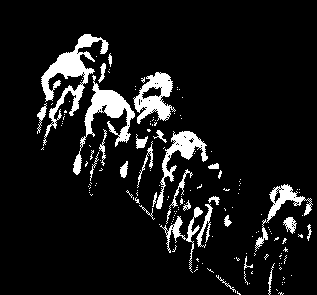- Butted 15 ga. spokes - A good choice for many sprint and all-event wheelsets with normal spoke counts (32 or 36 front and rear, some 28 fronts) where weight and windage are considerations (are they ever not?)
- Butted 14 ga. spokes - The way to go for heavier and/or more powerful riders, especially for rear wheels. Also an appropriate choice when the spoke count in a wheel drops to 28 (or fewer) spokes.
- Bladed and Elliptical spokes - In my opinion, none of the so-called "aero" spokes are particularly effective airfoils. Any aerodynamic benefit is primarily derived simply from the fact that the narrow axis of these spokes (typically 1.2 mm in both "bladed" or "elliptical" types) is more slender than the middle section of butted spokes (typically 1.55 mm. or so). "Bladed" spokes (DT or Wheelsmith) are 2 mm. (14 ga.) spokes that are swaged flat and because the long axis of the spoke is wider than will fit through the hole in a hub's flange, slotting the hub is necessary. Slotting a hub usually adds to the cost of a wheel, and frequently voids the hub's warranty from the manufacturer. "Elliptical" spokes (DT "Aero Speed" and Wheelsmith "AE 15", e.g.) are formed from 1.8 mm. (15 ga.) spokes, but their long axis will still fit through an unmodified hole in a hub flange (no slotting required). Since they're lighter, cheaper, nearly as aero as bladed spokes, and don't require butchering your hub flanges, elliptical spokes will often be preferred over bladed spokes in front wheel applications down to approximately 20 spokes (perhaps even less for 24" or 26" wheels). They should work as well in rear wheels in most cases where a similar number of butted 15 ga. spokes would serve. Generally, reserve 2.0 mm. bladed spoke use to wheels with very low spoke counts (24 or fewer front, 28 or fewer rear). Also, bear in mind that any twisting along the length of either a bladed or elliptical spoke will almost certainly create more drag than a conventional spoke of round cross-section.
- Tied/Soldered Spokes - A complete waste of money, time and space as far as I'm concerned. Even if you're a fan of tied spokes, the time to do it is after the wheel has been ridden and fully stabilized (re-trued); but why put all those little chunks of lead weights on your wheels??? Don't bother.
- Radial Lacing - A (mostly) harmless affectation on front wheels. Although it doesn't happen often, if the flange breaks on a hub that bears evidence of radial lacing, you're on your own as far as many manufacturers' warranties are concerned. Despite popular belief to the contrary, radial lacing is not more aerodynamic than crossed patterns. To prevent excessive loading at the elbow of the spoke, I normally lace radial wheels "spoke head out". I won't waste much time in the shop (or on the phone) trying to talk you out of radially laced front wheels - just know that it won't change your order of finish one way or the other and may be counterproductive in some situations.
- Half-Radial Lacing - The usual justification for half-radial lacing of rear wheels (to make spoke tension more equal between drive-side and non drive-side spokes) isn't as much of an issue since track rear wheels are much more symmetrical in dishing than rear contemporary road wheels. Again, don't get caught up in needless gadgetry - cross the rears on both sides for most applications. If nothing else, a half-radial rear will brand you as a slave to fashion.
- Crossing Spokes - Generally, go for the maximum possible, especially on rear wheels, up to 3x (36 spokes & under). 4x is usually overkill except for sprint tandems or 40 spoke rears.
- Brass/Aluminum Nipples - In theory, track wheels are prime candidates for using aluminum nipples. There's a smooth, manicured surface to play on (compared to ordinary road racing); and the events don't even go off in the event of rain. In practice, however, aluminum nipples still don't consistently have the lifespan that brass ones do and it may be impossible to reach adequate spoke tension with some rim/spoke combinations when using aluminum nipples. I offer aluminum nipples as an option on select wheels, but again, if you value overall lifespan over ultimate lightweight, it certainly isn't wrong to let 'em have brass nips. Should you think that the difference in weight of the nipples stands between your usual order of finish and a place on the podium, chances are that you've got work to do on some other part of your game. Wheels with low spoke counts (24 and under) and/or with rims without eyelets will usually be best served with brass nips.
|


